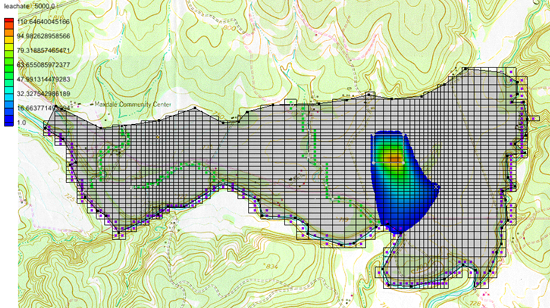In addition, separate flow simulation and calibration outside the transport model can result in substantial savings in computer memory. However, MT3DMS can also be coupled with a variably saturated or density-dependent flow model for simulation of transport under such conditions. The modular three-dimensional transport model referred to as MT3D was originally developed by Zheng at S. Finite Difference Model Type: Chapter 4 discusses the computer implementation of the numerical solution schemes. We also wish to thank Chris Neville, Mark Dortch, Daniel Feinstein and Erin Feehley who reviewed a draft version of this report and provided many valuable comments. MT3DMS is unique in that it includes three major classes of transport solution techniques in a single code, i. 
| Uploader: | Tagul |
| Date Added: | 2 December 2015 |
| File Size: | 47.49 Mb |
| Operating Systems: | Windows NT/2000/XP/2003/2003/7/8/10 MacOS 10/X |
| Downloads: | 71881 |
| Price: | Free* [*Free Regsitration Required] |
MT3DMS |
This manual describes the next-generation of MT3D with significantly expanded capabilities, including the addition of, 1 a third-order total-variation-diminishing TVD scheme for solving the advection term that is mass conservative but does not introduce excessive numerical dispersion and artificial oscillation; 2 an efficient iterative solver based on generalized conjugate gradient methods to remove stability constraints on the transport time stepsize; 3 options for accommodating nonequilibrium sorption and dual-domain advection-diffusion mass transport; and 4 a multi-component program structure that can accommodate add-on reaction packages for modeling general biological and geochemical reactions.
GMS allows you to interact with models in true 3D taking advantage of optimized OpenGL graphics and to create photo-realistic renderings and animations for PowerPoint, print, and web presentations.
Chapter 6 provides detailed model input instructions and discusses how to set up a simulation. WinZip is needed to uncompress the distribution files.
Employees in the News. MT3DMS is unique in that it includes three major classes of transport solution techniques in a single code, i.
GMS:MT3DMS - XMS Wiki
Gather background data from a variety of sources from GIS to CAD and m3dms online data from numerous databases of maps, images, mt3dns elevation data. However, MT3DMS can also be coupled with a variably saturated or density-dependent flow model for simulation of transport under such conditions.
If you mt3ds already have Acrobat Reader 4. In addition to the explicit formulation of the original MT3D code, MT3DMS includes an implicit formulation that is solved with an efficient and versatile solver. The appendices include information on the iterative solver, the computer memory requirements of the MT3DMS model, the interface between MT3DMS and a flow model, several post-processing programs, and mt3rms of abbreviated input instructions.
Geological Survey Software Release, 30 Septemberhttp: Goto to HydroGroup Home Page. MT3DMS can accommodate very general spatial discretization schemes and transport boundary conditions, including: MT3DMS can be used to simulate changes in concentrations of miscible contaminants in groundwater considering advection, dispersion, diffusion and some basic chemical reactions, with various types of boundary conditions and external sources or sinks.
More sophisticated, multispecies chemical reactions can be simulated by add-on reaction packages.

Software Services Support Downloads About. In addition, separate flow simulation mt3dsm calibration outside the transport model can result in substantial savings in computer memory.
We also wish to thank Chris Neville, Mark Dortch, Daniel Mmt3dms and Erin Feehley who reviewed a draft version of this report and provided many valuable comments. The chemical reactions included in the model are equilibrium-controlled or rate-limited linear or non-linear sorption, and first-order mt33dms or reversible kinetic reactions. Although the software has been subjected to rigorous review, the USGS reserves the right to update the software as needed pursuant to further analysis and review.
In instances where an mt3dmz is citing use of this software, it would be appropriate to cite both the report documenting the code and the specific software release version that was used. GMS provides a custom interface to the MT3DMS model offering a simple way to set model parameters and a graphical user interface to run the model and visualize the results.
The modular three-dimensional transport model referred to as MT3D was originally developed by Zheng at S.
Some distribution mt3fms are compressed by WinZIP. The model structure also saves execution time when many transport runs are required while the flow solution remains the same. Finite Difference Model Type: The exchange between the mobile and immobile domains is specified by a mass transfer coefficient. The current work was funded, in part, by the U.
GMS:MT3DMS
Users do not need a license or permission from the USGS to use this software. Chapter 7 describes the benchmark and example problems that were used to test the MT3DMS code and illustrate its applications.
Since no single numerical technique has been shown to be effective for all transport conditions, the combination of these solution techniques, each having its own strengths and limitations, is believed to offer the best approach for solving the most wide-ranging transport problems with desired efficiency and accuracy. MT3DMS is implemented with an optional, dual-domain formulation for modeling mass transport.
The finite-difference method can be fully implicit without any stability constraint to limit transport step sizes, but the particle tracking based Eulerian-Lagrangian methods and the third-order TVD method still have time step constraints associated with particle tracking and TVD methodology.
Since most potential users of a transport model are likely to have been familiar with one or more flow models, MT3DMS provides an opportunity to simulate contaminant transport without having to learn a new flow model or to modify an existing flow model to fit the transport model.


No comments:
Post a Comment